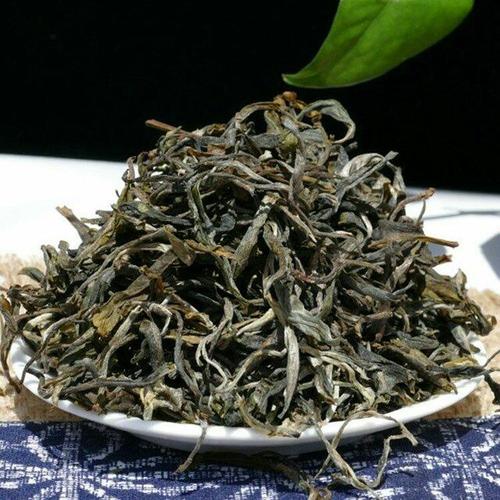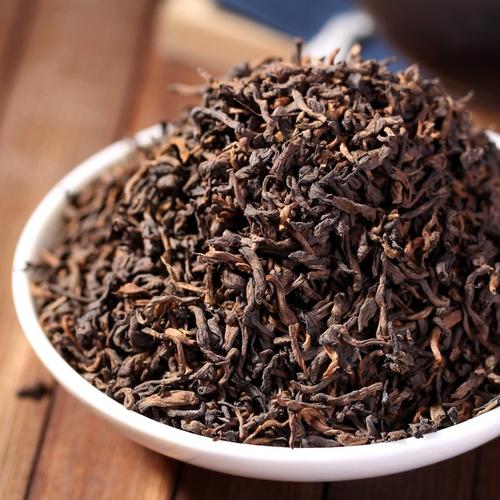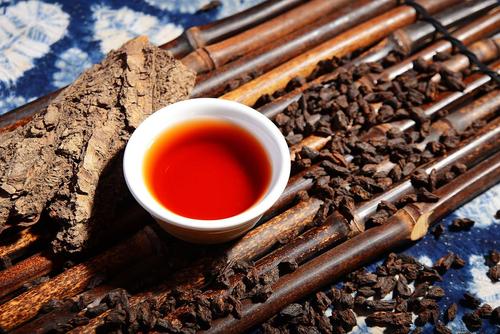Pu’er tea is mainly grown in Xishuangbanna, Lincang and Pu’er in Yunnan Province, China. Its liquid is bright orange in color and has a mellow taste. It is made from fresh tea leaves through the processes of setting, fixation, rolling, unraveling, and sun drying.
In ancient times, pu’er tea was divided into two categories: one is loose tea and the other is compressed tea. Pu’er tea has a long history and many varieties, and even the method of drinking the tea varies. With the changes of the times, pu’er tea is also slowly developing, and the classification of pu’er tea has become more and more complicated and detailed.

Green tea is made into dry tea through a series of processes. The dry tea is then further processed into loose tea or various compressed teas and stored in a natural way to allow natural fermentation. Generally, pu’er raw tea is dark green or deep green, with slight yellow or slight red. If it is stored for a long time, pu’er raw tea will be brown in color. The liquid of pu’er raw tea is clear and dark green in color. If pu’er raw tea is stored for a long time, its liquid will be bright yellow, orange yellow, or orange red in color. Pu’er raw tea has a strong flavor, with slight bitterness.

After green tea is made into dry tea, it is processed quickly by artificial fermentation. Generally, pu’er ripe tea is brown, red brown, or dark in color. The liquid of pu’er ripe tea is clear and red in color. If it is processed through light fermentation, the liquid will be chestnut red in color. If it is processed through heavy fermentation, the liquid will be dark red in color. The liquid has a mellow taste, with no bitterness.
Pu’er tea can be stored in a clean, ventilated, temperature-friendly, and odor-free warehouse with a humidity of 8% or lower to allow it to ferment slowly. This type of pu’er tea is more suitable for long-term storage. If the storage environment meets the standards and is stored properly, this tea will be a rare treasure.

Pu’er tea can also be stored in a basement, cellar, or other humid, unventilated environments to speed up its fermentation. The storage time of wet-warehouse pu’er tea is relatively short, and you can feel the flavor of the stored tea after one or two storage years.
The processed raw or ripe pu’er tea is not compressed so as to make the loose tea. Loose tea has two types: raw pu’er loose tea and ripe pu’er loose tea.
After raw or ripe pu’er tea is produced, it is piled, steamed, boiled and compressed to make the compressed tea. Generally, compressed tea contains cake teas, brick teas, bowl teas, etc.
Pu’er Tea has a variety of effects such as lowering blood lipids, losing weight, inhibiting bacteria, improving digestion, warming the stomach, and quenching thirst.
Long-term drinking of pu’er tea can reduce cholesterol and glycerol and treat obesity. Drinking pu’er tea has physiological effects such as vasodilation, decreased blood pressure, slowed heart rate, and decreased blood flow in the brain. It also has a good therapeutic effect on patients with hypertension and cerebral arteriosclerosis.
The film formed by pu’er tea is attached to the surface layer of the stomach, which provides a protective layer for the stomach. If you drink pu’er tea for a long time, your stomach will get nourished and protected.
Yunnan big leaf tea is rich in tea polyphenols, which has an anti-inflammatory effect.
Catechin compounds in pu’er tea have an anti-aging effect.
Pu’er tea helps regulate the stomach and intestines and restore their normal function.
1. It is recommended to use 3-4 g of pu’er tea per 200 ml of water.
2. Put the tea leaves in the teapot and then pour in a little hot water.
3. Shake the teapot gently to wash out impurities from the tea leaves.
4. Remove the water and leave the tea leaves in the teapot.
5. Pour hot water in the teapot and steep the tea leaves for about three minutes.
6. Pour the tea liquid into the teacup and enjoy the mellow, thick and smooth liquid.
7. The tea leaves can be steeped for about six times.
There is more oxygen in the circulating air, which is conducive to the reproduction of some microorganisms in pu’er tea. So, it can speed up the change of tea leaves. But pu’er tea cannot be hung on the balcony. The surrounding environment of pu’er tea should not have an unpleasant odor, or the tea will change its taste. So, it cannot be placed in the kitchen or other environments with a living or industrial odor.
The storage temperature of pu’er tea cannot be too high or too low. The temperature should be based on the local environment. The normal indoor temperature is acceptable. It is best to keep the storage temperature between 20-30℃. If the storage temperature is too high, it will speed up the fermentation of tea leaves. Pu’er tea cannot be exposed to the sun, and it is better to keep it in the shade.
High-quality pu’er tea should be stored in dry warehouses. If the environment is too dry, it will slow down the aging of pu’er tea. So, humidity is also an important factor. In a drier environment, a small glass of water can be placed beside the tea leaves to increase the humidity in the air slightly. The environment cannot be too humid, or it will cause rapid changes in pu’er Tea. These changes often make pu’er tea undrinkable.
1. It is not advisable to steep pu’er tea for too long before drinking. Avoid drinking pu’er tea overnight.
2. Avoid drinking plenty of pu’er tea before and after meals. Pu’er tea is best consumed half an hour after a meal. If you eat too little, you should not drink too much pu’er tea.
3. Avoid drinking too hot or too cold pu’er tea.
